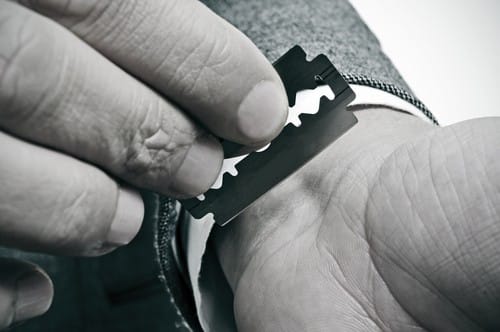An estimated 2.9 million teens, or about 12 percent of adolescents, struggle with major depressive disorder or have had a significant depressive episode. Some organizations have called it a teen epidemic, although the issue of teen mental health is more pervasive – in fact, the WHO estimates that teen mental health rates are worsening all over the globe, despite growing awareness and investment in better mental health resources and availability.
One of the major reasons teens struggle so much is that so few of them get the help they need. Only about 40 percent of adolescents who need mental health treatment for conditions like depression get it. Given that many teens still don’t want to broach the topic or don’t know how to address or identify their thoughts, for parents wanting the best for their children, one of their most important challenges is determining whether their teen is or isn’t affected by a mood disorder.
In this article, you will discover the 12 common teen depression symptoms.
Identifying the Signs and Symptoms of Teen Depression
Recognizing teen depression by its symptoms is not always easy. Sometimes, parents can struggle to differentiate between a mental health episode and “normal” teen moodiness.
But aside from a professional diagnosis, an important characteristic is time. Depression symptoms must persist for weeks, then months, for a teen’s mood to indicate a mental health problem.
Being upset, anxious, or irritable is normal, especially under difficult personal circumstances. And for teens, many things qualify as difficult personal circumstances.
However, depressive disorders occur and persist even under normal or happy circumstances.
Moments of joy are fleeting, and many teens with depression will experience anhedonia (an inability to feel happy), lose interest in old hobbies, struggle to maintain relationships with friends, and give up on consistent hobbies for lack of motivation. Other classic signs of teen depression include:
-
- Overt or significant interest in death and the morbid.
Teens with depression are more likely to be preoccupied with thoughts of death. A common thread of thinking is imagining or fantasizing about what it would be like for others after they die and whether they would be missed. - Frequently discussing or joking about suicide.
Suicidal ideation and suicide attempts are some of the most harrowing and severe symptoms of depression. There are often no warning signs for loved ones, and the urge can strike from anywhere for no reason. - Disinterested in old hobbies.
Loss of joy is a major symptom of depression. This includes a loss of interest in old hobbies. - Struggling to be socially available.
It can be hard for people with depression to continue cultivating and managing their relationships with others. They are likely to push people away. - Feeling constantly demotivated.
This extends past work and school into everyday living. It can sometimes feel impossible to get out of bed, let alone take a shower or get into a fresh change of clothing. - Chronically tired or fatigued despite oversleeping.
Depression comes with many physical signs, including general fatigue and tiredness. - Poor sleep hygiene and insomnia.
Despite being chronically tired, many depressed teens struggle to sleep or maintain a healthy sleep cycle. - Signs of physical self-harm.
These include hairpulling, cutting, excessive nail-biting, burning, or picking at scabs. - Language that implies self-hatred (self-deprecating jokes, constant negative affirmations, guilt, and regret).
- Much more likely to engage in risky behavior.
This can range in anything from adrenaline-seeking behavior to illegal behavior, such as theft, speeding, or public sex. - Irritability and sudden outbursts from time to time.
While teens with depression have a low mood, they can still get angry (or even experience laughter sometimes). In fact, they may be more likely to lash out at others and struggle to accept advice or affirmation. - Co-occurring mental health issues (especially anxiety, ADHD, or complex grief).
- Overt or significant interest in death and the morbid.
If your teen’s sadness persists for weeks, if not months, and attempts to cheer them up backfire or haven’t worked well, they may be going through more than just a temporary rough patch.
Depression is also Physical
Long-term sadness is a classic sign of depression, but many parents and friends miss the physical signs that often co-occur.
Depression can drastically impact a person’s sleep cycle, often leading to chronic oversleeping or undersleeping and insomnia.
Rapid weight gain or weight loss is also common. Some teens react to symptoms of depression with eating binges, more snacks, less physical activity, or increased “boredom eating”.
Others react physically to the stress through lowered appetite, rapid weight loss, and a disinterest in food in general.
Pain is another common physical symptom of depression, especially random pain. Depression can be precipitated by or can include episodes of joint pain and stomach pain, even in teens, and often co-occurs with irritable bowel syndrome.
For teens with other chronic health conditions – especially conditions that include chronic pain – depression can make symptoms worse, increase pain sensitivity, and slow treatment.
Depression Has Terrible Bedfellows
While not a symptom, the majority of teens with major depressive disorder or similar mood disorders also struggle with at least one other mental health issue or are at a much greater risk for conditions such as generalized anxiety disorder or ADHD.
Sometimes, it’s a chicken-or-egg situation, where it is hard to tell which condition came first or how they affected each other. Most mental health conditions can lead to an increased risk of depression and vice versa.
While it’s common, this can also complicate treatment. Helping a teen solely via talk therapy and antidepressants might not help address their ongoing substance use addiction, for example, if they continue using it at home or school. Inpatient treatment at specialized mental health facilities can help teens with multiple mood disorders or co-occurring mental health issues.
There Are Many Kinds of Teen Depression
Many teens struggle with major depressive disorder, which is often also referred to as clinical depression. But it is not the only depression teens are affected by. Another common mood disorder is bipolar disorder, which includes symptoms of depression alongside mania or hypomania. Where depression is chronically low mood, mania involves drastically and uncharacteristically high mood episodes alongside dangerous symptoms such as illusions of grandeur, boundless energy, greater risk taking behavior, and a greater risk of personal harm. Sometimes, teens with mania seem to never or barely sleep and might appear hyper-functioning, but to their own long-term detriment.
Hypomanic symptoms are less severe and less likely to cause hospitalization but may still be significant or out-of-character. Teens with hypomania are also more likely to struggle with episodes of severe depression in between manic symptoms.
Girls may struggle with premenstrual dysphoric disorder. Unlike major depression, which may have a number of confluent neurological, genetic, and social causes, the premenstrual dysphoric disorder is linked to hormonal changes during a teen’s menstrual cycle. While it is compared to PMS, symptoms are often much more severe and can include suicidal thoughts and self-harm. PMDD is also typically a lifelong condition.
Another common form of teen depression is seasonal affective disorder. The most common type of seasonal affective disorder is winter depression, where teens start feeling symptoms of depression only around the winter months. Causes or factors are believed to include a lack of sunlight and an increase in holiday- and weather-related stressors.
Teen depression is an incredibly common and very complex condition, with different contributing factors and co-occurring issues. Treating your teen’s depression (or your own) will take time, patience, and especially support.









